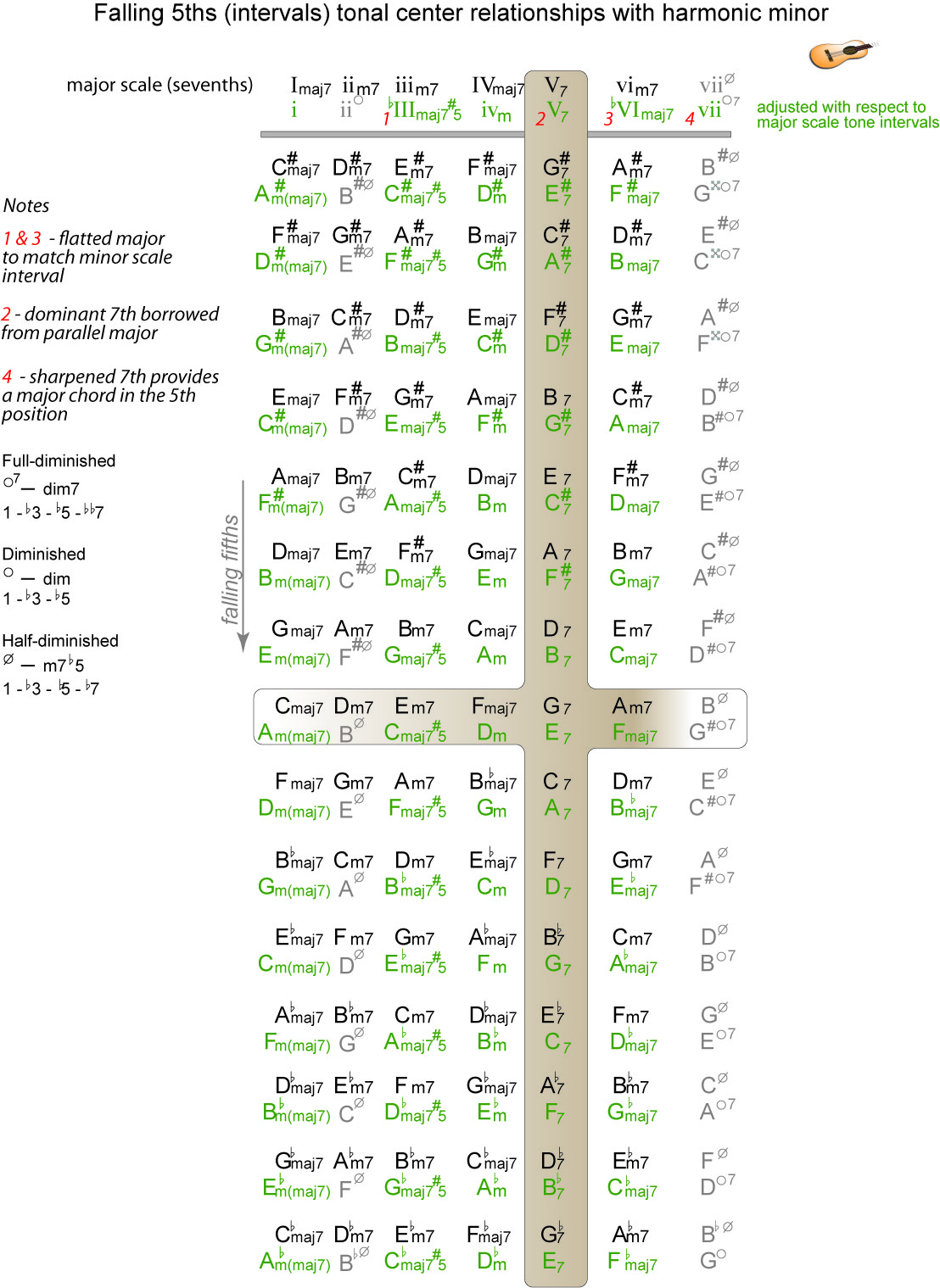A distillation of ideas on chords and the major scale
This is a way of looking at chords on the guitar that is easier to grasp and less memory intensive than the traditional way it is presented.
This all started to gel for me after taking guitar lessons with a wonderful musician called Mark Vanderdool in Montreal,
my eyes and ears were opened:
http://studiovandendool.com/
There are 5 different ways to play a major scale on the guitar. They each have a distinct
pattern that can be played anywhere on the neck of the guitar. They are distinguished by
the fact that the tonic (root or 1st note of the scale) starts on the 6th, 5th or 4th
string and the subsequent notes are located downwards towards the head of the neck or
upwards towards the body of the guitar. The tonic of the scale is identified by a white circle.
Here are the five patterns, sometimes called positions:
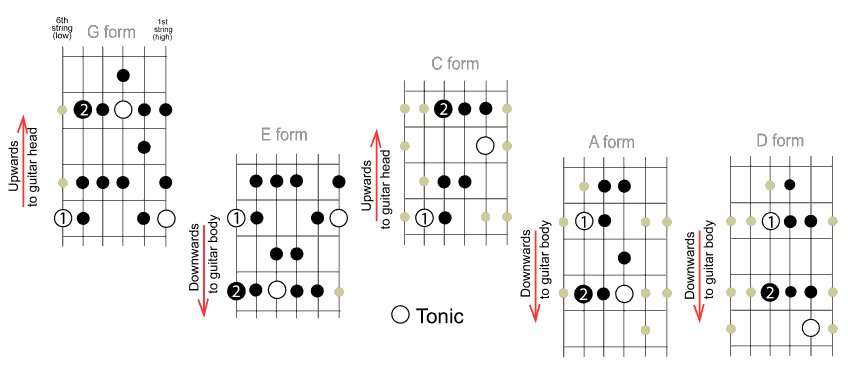
Each position has a major scale shown by the white (root) and black dots. These positions cover a
range of 4 to 5 frets. The black dots cover either one octave or two. The grey dots are notes
in the same scale which are either higher or lower than an octave and complete the position.
These five scale patterns are often called positions 1, 2, 3, 4 and 5. Calling something as complicated
as this no. 1, 2, 3, 4, and 5 does not provide any association to help you remember the patterns.
Fortunately they can be named after the chord form that the first note belongs to providing a
link between chord and scale. So they can be named the G form scale or position, E, C, A and D form position
which is much easier to remember and more practical because chords and scales belong together.
The first note of each major scale position defines 5 different chord shapes or forms and as you
would guess they are the G, E, C, A and D form chords.
Why D form and not just D chord, because this D shape can be played up and down the neck, there
is only one place on the neck that it can be called a D chord.
One way to practice the 5 different scale forms is to play the tonic first
instead of always starting on the 6th string. This way your ear will help you play an
octave correctly and you can add the low or high notes easily to cover a 4 or 5 wide fret zone.
How does this help you be a better musician? It gives you more options; it allows you to
play the same notes or chords on a different part of the neck which will be 1 or 2 octaves
up or down. It opens up all the notes of the guitar to you. Nice eh?
The following chart provides all the 3-note chords that correspond to the notes of the
F major scale. The notes of the chords are chosen by starting on a note then skipping
the next note, keeping the third note, then skipping the next note and keeping the fifth
note. For example, the F chord of the F major scale has the notes F, A and C, so we
skipped the A and B notes. This is known as harmonizing the major scale.
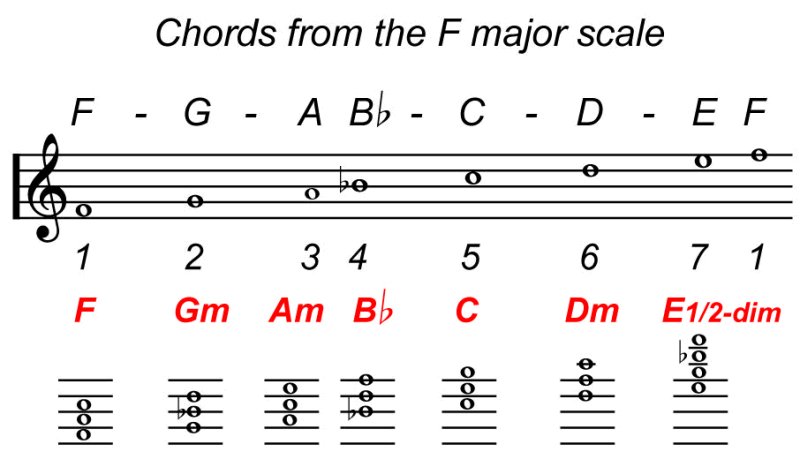
An important characteristic of chords that you will recognize in songs is whether they are major or minor. The chords of a
major scale are made of major and minor chords. All songs in the Western world are played in a
major scale or a variant of it. Our ear can be easily trained to detect a major chord and a minor
chord. This is very helpful if you want to learn a song by ear instead of having to go out and
buy the partition.
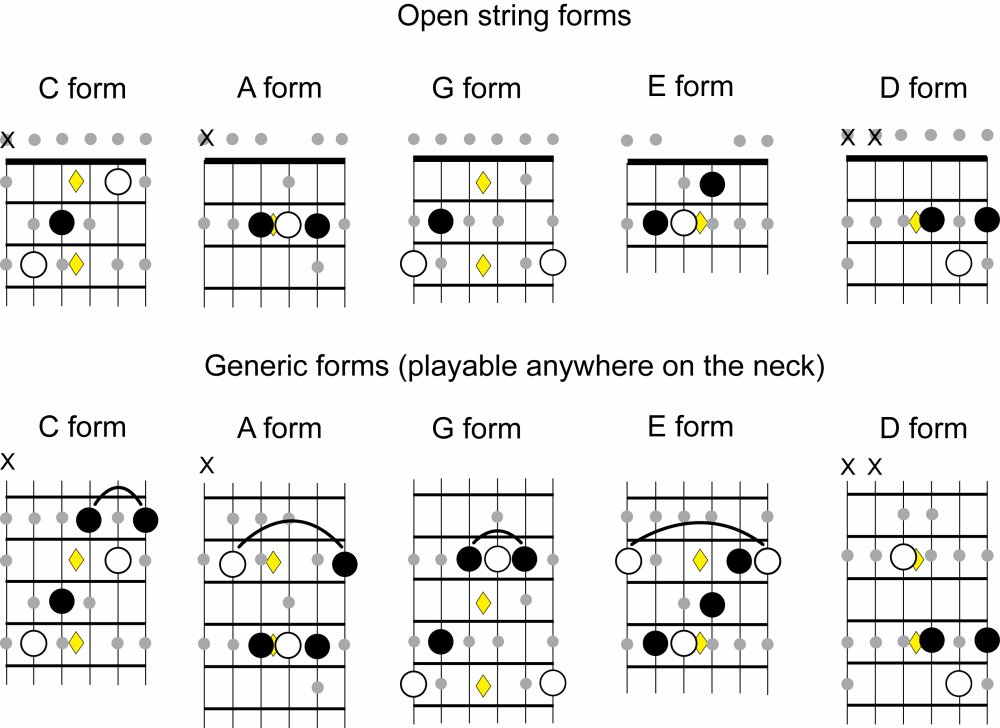
You are probably wondering why there are X's on the 6th string of the C and A form chord and
on the 6 and 5th string of the D form chord. The X indicates that the note is not to be played.
In the case of the C form chord (open form) you could play the note on the 3rd fret which is a
G since the G is also a note in the chord that belongs to the scale. However, a C chord should always start with a C, if
it doesn't it is known as an inversion and depending on which note is played first it will be
the 1st or second inversion. The first inversion is indicated with an uppercase 6 or C6 and
the second inversion as uppercase 6 and lowercase 4 or C64. The first inversion is also known
as C/E or C slash E indicating that the E is played first. Many songs have chords with a
first or second inversion, it can be hard to detect and looking for that chord maybe difficult
if an inversion is not suspected. An inversion often occurs when the song has a pronounced ascending or descending bass line.
In the case of the A form open chord the 6th string cannot be played at all because it is
not a part of the chord. The chord should start on the open 5th string which is the A.
In the case of the D form open chord the 6th and 5th strings are normally not played and you
start on the open 4th string which is a D. However you could start on the 6th string which is
an F# and that is the first inversion D6 or D/F# and you can also start on the 5th string which
is an A forming the 2nd inversion or D64 or D/A.
The distinction between major and minor depends on the interval between the first two notes
of the chord, if the interval is a major third which is 4 fret-steps (or frets) on the guitar
it is a major chord, and if it is a minor chord it is 3 fret-steps. A fret-step is often called a
semi-tone or a half-step. I find this terminology confusing and if you are playing the guitar every
fret moves you up or down by a semi-tone so why not call them fret-steps. The interval between the
1st and 3rd note is a perfect fifth or 7 fret-steps and is the same for a major or minor chord.
Because the notes of the major scale are separated by different intervals, when you form a
chord by starting on any note and skipping every subsequent note you get a pattern of chords, major,
minor, minor, major, major, minor and diminished, and this applies to any major scale. For example
the C major scale will have the chords C, Dm, Em. F, G. Am and Bdim.
So once you figure out the key of the song which is often the first
or last chord played then when you hear the other chords of the song most of them will likely
belong to the scale of that key and they will be familiar to you.
Notes in chords are expressed as tones, numbers are used and they provide the interval between the tones which is what defines a chord.
For example a major chord has a major 3rd (M3) interval between the number one tone and the second tone, and then a perfect 5th interval between the number 1 tone and the third tone (1-3-5).
The minor chord has a minor 3rd (m3) interval between the number one tone and the second tone, and then a perfect 5th interval between the number 1 tone and the third tone (1-3-5).
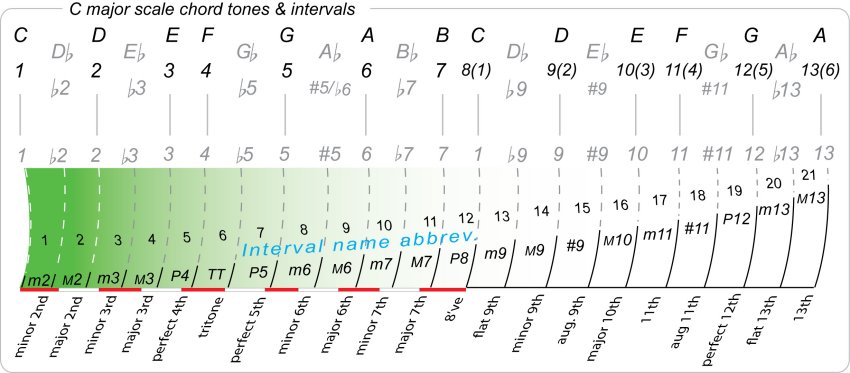
The CAGED system is at the heart of the guitar, if you play the same chord, for example C major in it's different chord forms, you will see
that many notes are common and overlap between adjacent forms.
But not only that, those common notes form chord tones that are identical. These chord forms are inter-twined, one leading into the next.

The following chart provides the 3-note chord forms (C-A-G-E-D) for the major scale, the chords are based on scales that correspond to the different starting chord forms.
For example, a scale that starts on the 6th string and has it's notes going towards the headstock is the G scale position.
All the other chords in that scale
will use the notes of that scale and are located within the range of that scale which is within 4-5 frets.
This first chart is the major chord scales in the open postion. The column named I is the root chord form for the five different scales
that correspond to C, A, G, E & D. These chords can be played only at one position on the neck.
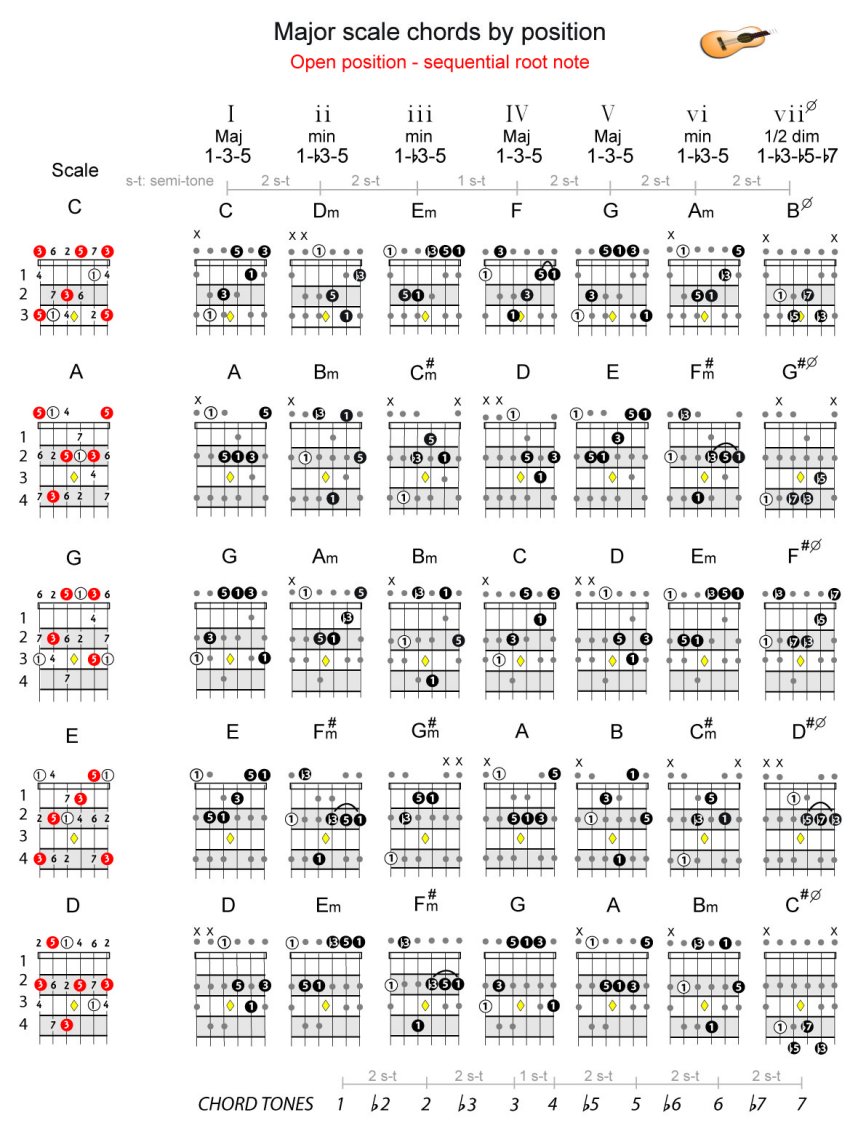

The major scale 7th open chords by postion. These chords can be played only at one position on the neck.
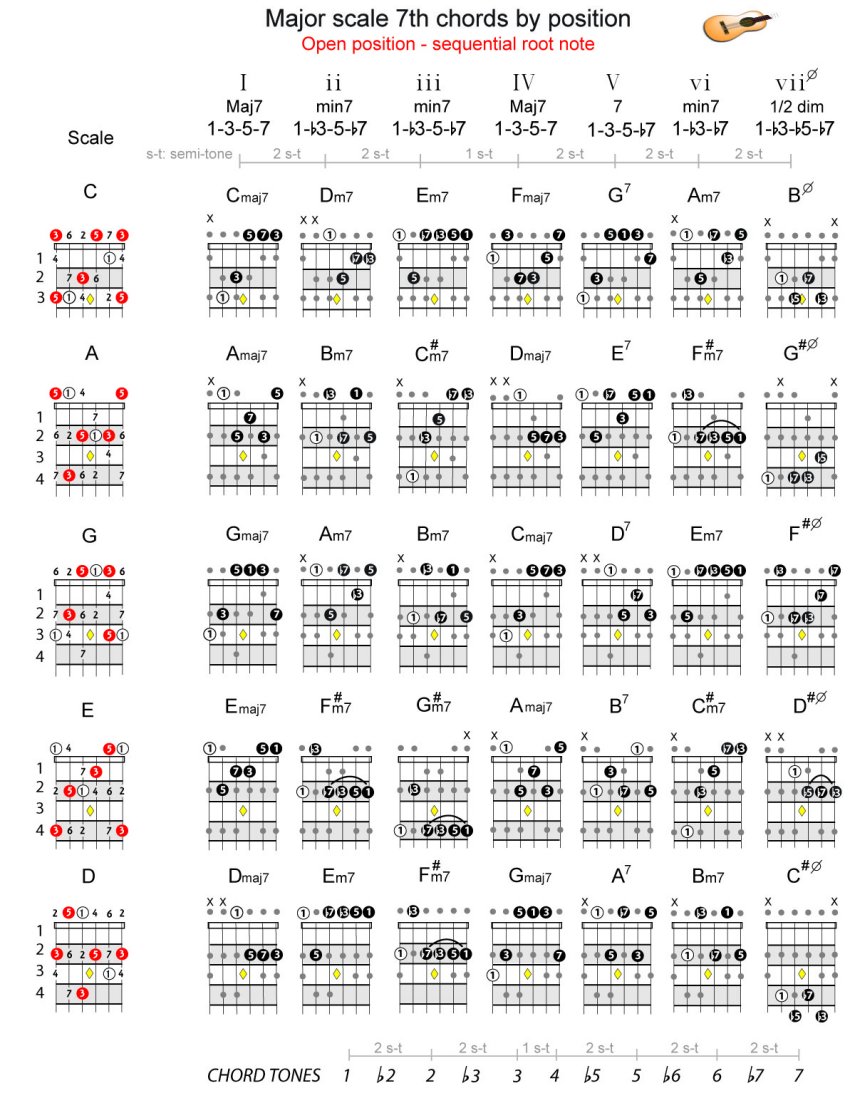

This chart provides the 3-note fretted chord forms for the major scale. These chords can be played anywhere on the neck.
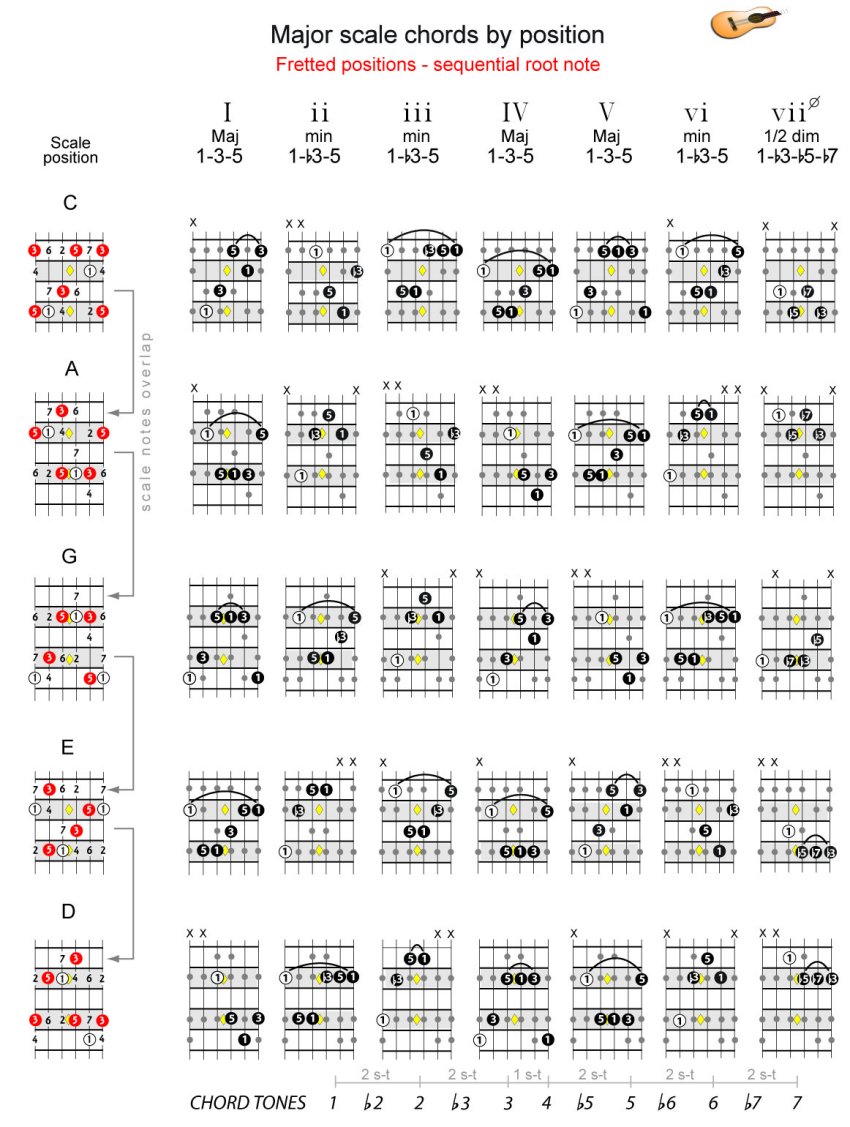

This chart provides the fretted 7th chord forms for the major scale. These chords can be played anywhere on the neck.
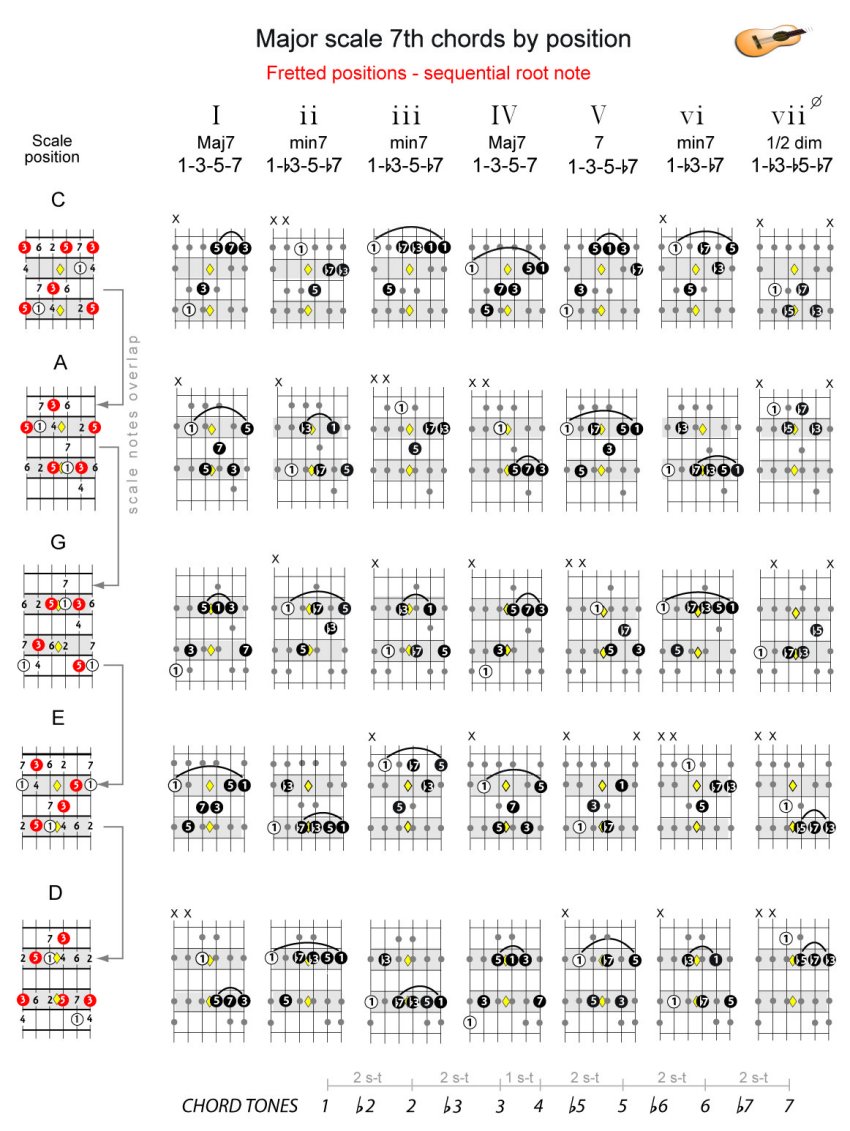

There are also many minor scales that are derived from the major scale.
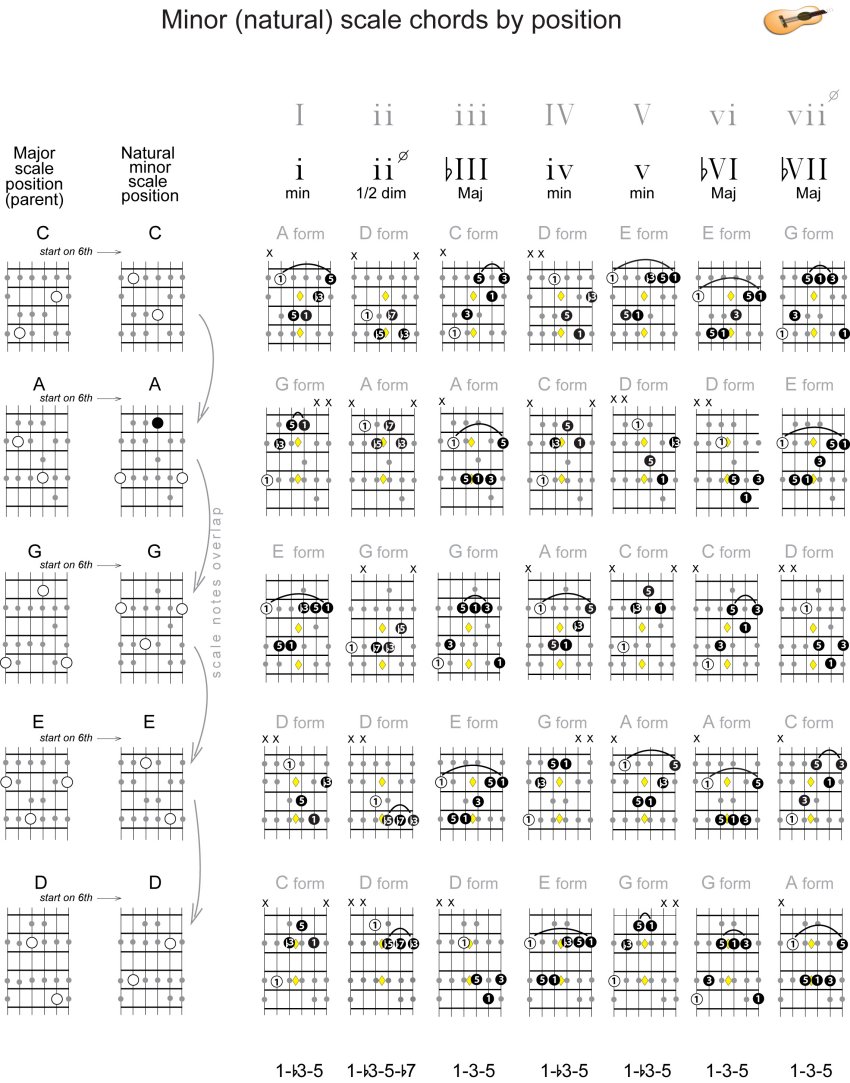

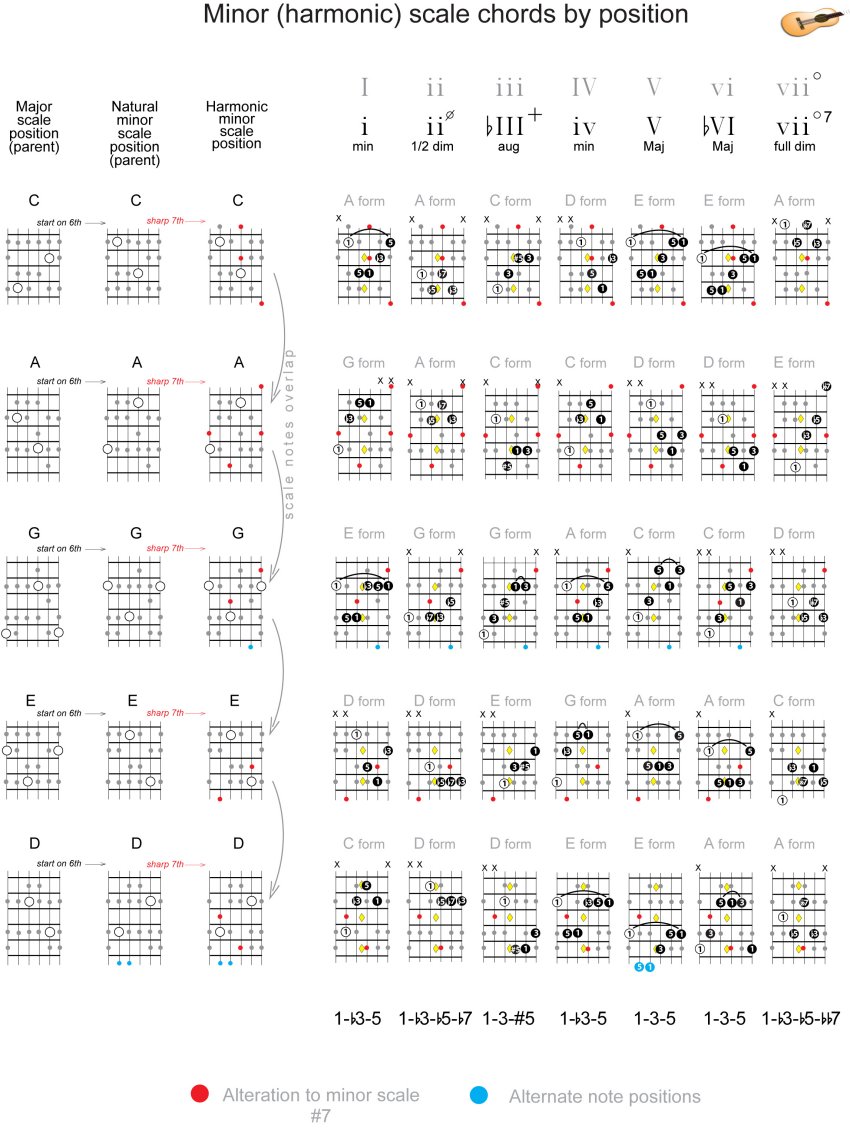

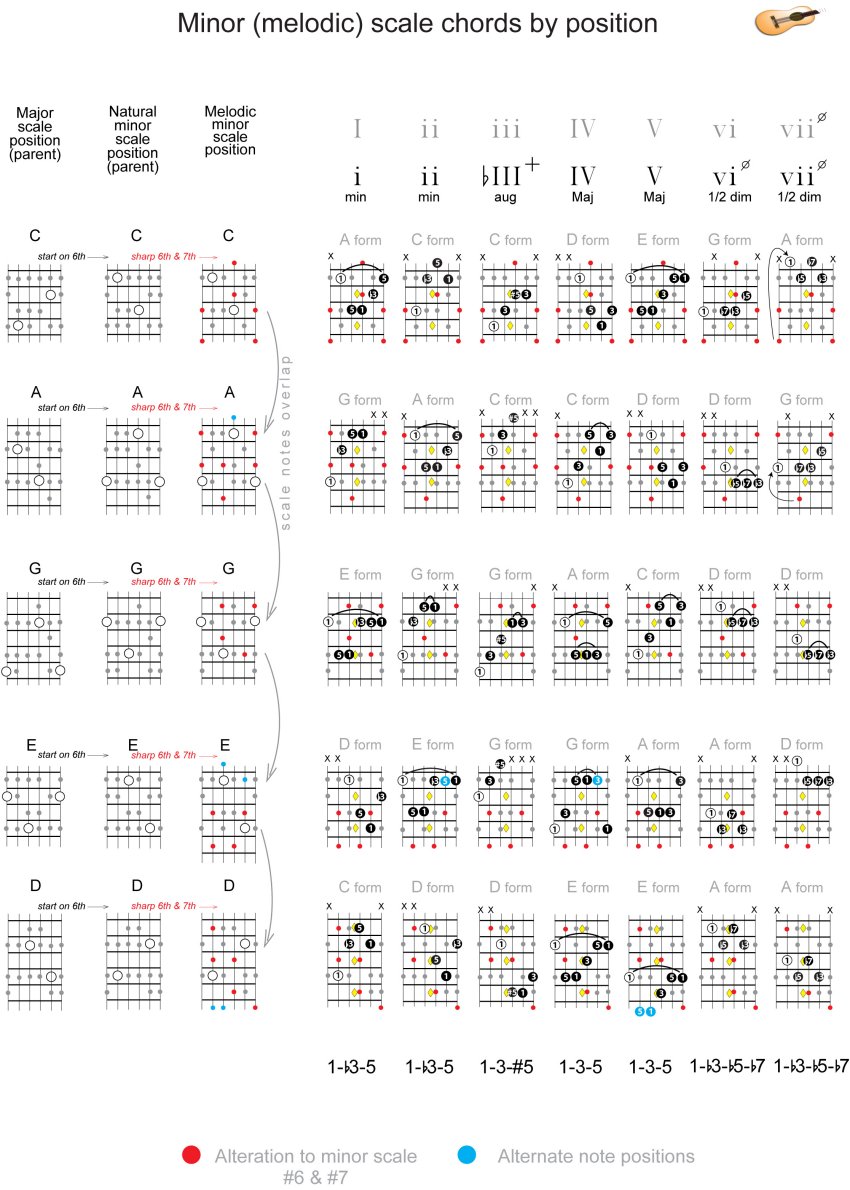

The following chart is helpful in finding chords of different qualities and also finding where identical notes are located on the fretboard.
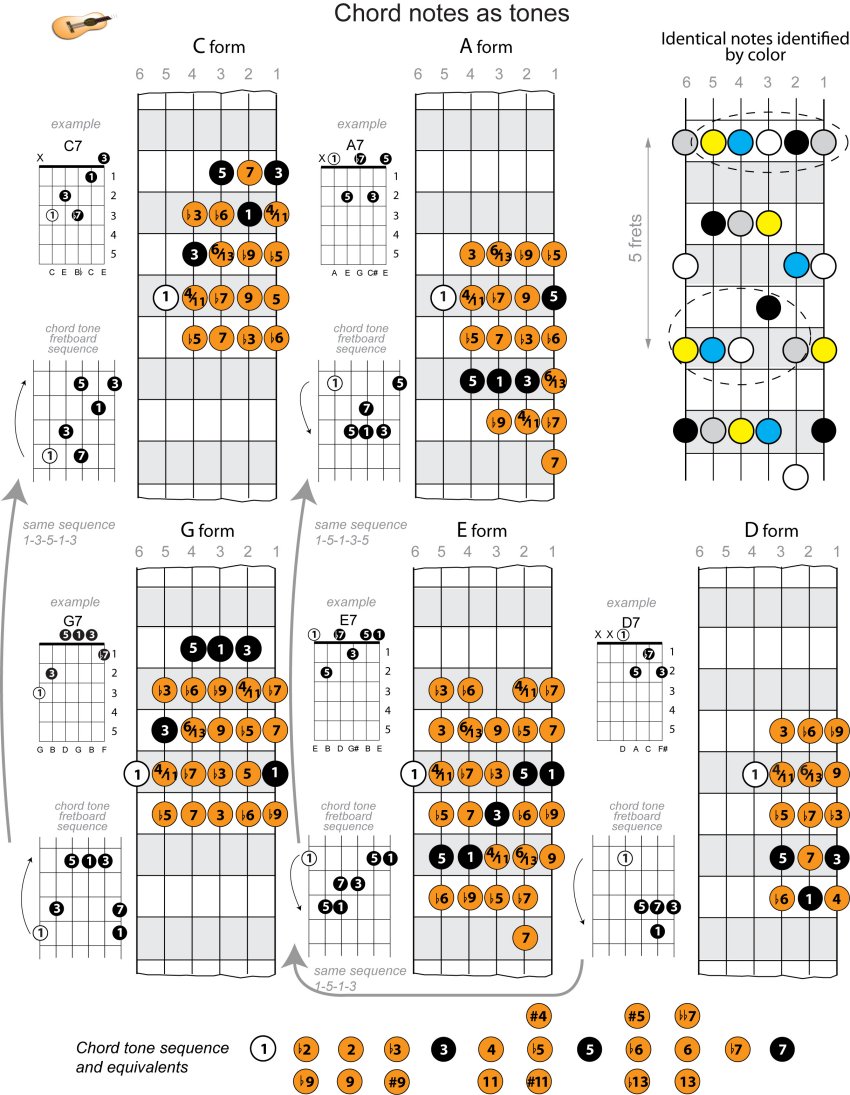

The major scales (triads) are positionned vertically in the falling fifths order. It's very useful to figure out key changes in music.
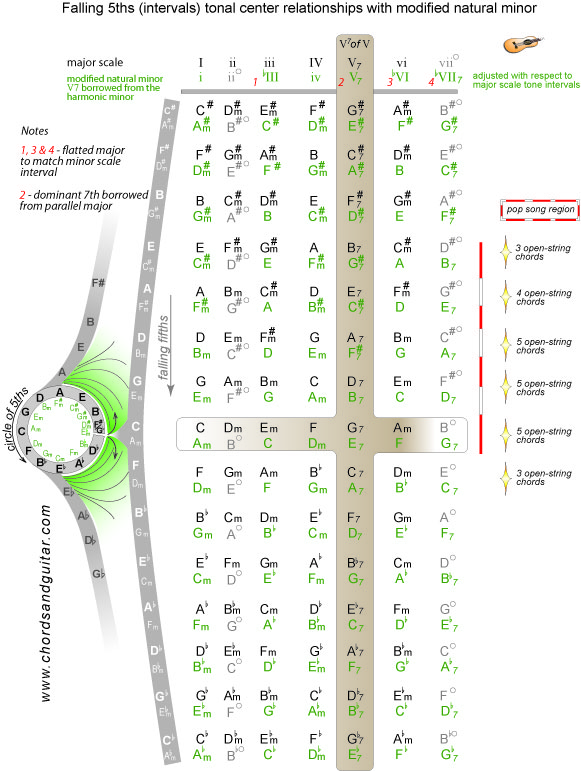

The major scales (sevenths) are positionned vertically in the falling fifths order.
